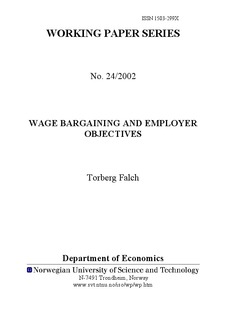| dc.contributor.author | Falch, Torberg | nb_NO |
| dc.date.accessioned | 2014-12-19T14:31:57Z | |
| dc.date.available | 2014-12-19T14:31:57Z | |
| dc.date.created | 2006-10-05 | nb_NO |
| dc.date.issued | 2002 | nb_NO |
| dc.identifier | 126116 | nb_NO |
| dc.identifier.uri | http://hdl.handle.net/11250/267161 | |
| dc.description.abstract | This paper compares union wage bargaining outcomes across different types of employers. Five different employer objectives are discussed; profit–, welfare– and output maximization, and two specifications of a Leviathan. The model shows that the ordering of the union wage level across employer types depends on the functional form of product demand. With constant elasticity of product demand, the wage tends to be lowest in the output maximization case, while with a linear product demand, the wage tends to be lowest under welfare maximization. | nb_NO |
| dc.language | eng | nb_NO |
| dc.publisher | Institutt for samfunnsøkonomi | nb_NO |
| dc.relation.ispartofseries | Working Paper Series, 1503-299X; 2002:24 | nb_NO |
| dc.title | Wage Bargaining and Employer Objectives | nb_NO |
| dc.type | Research report | nb_NO |
| dc.contributor.department | Norges teknisk-naturvitenskapelige universitet, Fakultet for samfunnsvitenskap og teknologiledelse, Institutt for samfunnsøkonomi | nb_NO |
